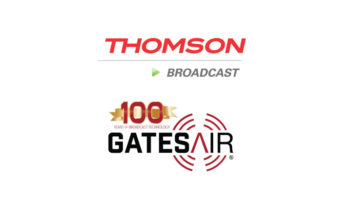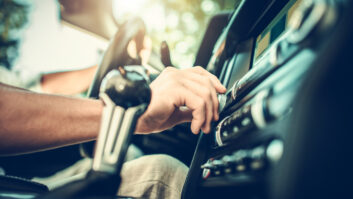Guy Wire Says It’s Time to Reorganize AM’s Family Living Arrangements
FCC adoption of standards and rules for HD Radio is expected sometime later this year.
NRSC-5 was recently adopted during NAB2005 and is the culmination of many years of work by the NRSC subcommittee on DAB. It no doubt will be substantially adopted by the commission for both FM and AM services, including AM HD nighttime operations.
The industry is for the most part applauding this seemingly long-overdue event, especially for FM. But many are still fearful of serious interference fallout when AM HD is widely deployed full-time.
We’ve heard that a few subcommittee members were pressed gently after voicing their reservations, to ensure the NRSC-5 standard could pass unanimously. There have been ongoing concerns about reduced coverage, especially at night and during critical hours, caused by adjacent-channel interference from the AM HD side carriers. These land squarely on the first adjacents and have been demonstrated to cause elevated noise interference in second- and even third-adjacent channels, especially on wider bandwidth receivers.
THE INTERFERENCE DILEMMA
Based on results from their own studies, Ibiquity has long maintained that any perceived nighttime HD Radio interference to stations from strong adjacent channels is not going to be a big deal. They say only a few isolated cases will experience significant skywave-to-groundwave interference. Quite a few smaller-market AM owners would disagree.
The more significant problem, which Ibiquity does acknowledge, will be interference to the secondary and skywave coverage areas of clear-channel stations. This will be manifested as holes in areas where previously useful analog reception will be wiped out by groundwave signals of smaller-market stations that light up AM HD operations on nearby channels.
Very little is known about how well HD Radio reception will perform in most interference-limited situations, especially skywave reception for clear-channel stations that reach significant audiences. That little secret worries some NRSC members.
I have long maintained that opening up AM HD Radio for all stations at night will precipitate more problems and formal interference complaints than Ibiquity is suggesting will likely occur. We’ll learn over time how well the FCC’s proposals for negotiated digital power reductions will work.
Ibiquity and the NAB completely support the notion that deploying AM HD full time will serve the greater good to accelerate AM into a higher-quality digital future despite any potential loss of coverage for many stations.
THE TRUTH
Both parties are more than willing to let the interference chips fall where they may. Unfortunately they continue to ignore the underlying symptoms of a very sick patient and insist on administering a new wonder drug that may induce crippling side effects more than it promotes healing and recovery. At the root of the AM illness are simply too many signals causing too much interference in a channel spacing scheme that allows stations legally to encroach into their neighbor’s space. All other broadcast services are allocated with guard-band protection between adjacent channels.
Many respected engineers have long observed the AM band is already a disaster at night, choked with noise, interference and colliding signal wreckage on most channels. Only a few signals in most markets provide reliable wide-area coverage in most regions of the country.
There is a suspicion, held by quite a few of us, that some of the interference is being generated by smaller-market stations that are required by license to drop power radically at night or switch to limited-coverage directional antenna patterns, but have chosen to “forget” to switch from day to night mode. Many have DA systems that are woefully out of spec due to negligence and lack of maintenance. Too many have been getting away with such blatant illegal operations for very long periods of time, knowing that FCC field offices are under-staffed and under-budgeted to be able to deal with it.
The sad reality about the AM band is that there are only a few stations in most markets that are truly profitable or that can deliver significant listener support. The full-time 50 kW powerhouses will probably always enjoy solid ratings and revenue performance. Almost all rated markets have at least one AM talk or news/talk station that delivers full-time market coverage and can compete near the same level with most FM stations.
After that, sports and maybe a foreign language station or two usually struggle to hold their own. At the bottom of the AM food chain are all the rest – mostly automated religious or satellite-fed “repeaters” that make little or no money and get full-time life-support from sister FM stations. Quite a few fail to crack or just barely make reporting minimums to be rated in Arbitron or other surveys.
If it were not for consolidation, many of these stations would have gone dark long ago. Owners keep them alive in hopes HD Radio will increase their value and music formats might again someday be competitive on AM. At a minimum, they are holding out for some religious or ethnic operator to buy them so a profit on their original investment can be made. But values of AM stations that do not enjoy full-time facilities or cover their markets adequately have languished for a long time.
With the explosion of the Internet, satellite radio, portable MP3 players and iPods – and, very soon, cell phones that can stream live content as well as multichannel FM HD Radio – the mass-media playing field has become highly fractionalized.
THINNING THE HERD
The growth and proliferation of infotainment choices is making AM radio’s chances for regrowth and long-term success more problematic than ever. It is already causing deterioration of values of marginal AM facilities in many markets. The introduction of multichannel programs on FM HD will undoubtedly accelerate that deterioration.
If there is a viable future for the AM band, it will be dependent on a sweeping initiative to clean it up and thin the herd so that the stronger members can improve and become better prepared for survival. It’s the best way AM HD enhancements can be effective for stations that can claim or will be able to secure solid full-time coverage in their markets.
One of the more frequent concerns voiced by smaller AM owners is the cost burden of adding HD Radio and the attendant updating of transmission systems that will be required. Many will simply not be able to afford it. That could be incentive enough for some to sell out and take a loss. But the band would be better served if most could simply go dark, turn in their licenses and receive some form of meaningful compensation, perhaps from other station owners who would benefit by then being able to expand their own coverage areas.
With so many mass media choices out there in markets of all sizes, we have long passed the point of concern that the loss of a local-market AM radio station somehow endangers the citizens of that market from being adequately and properly served with public interest programming. The provision in the rules that a certain minimum number of licensed radio signals must be preserved when facilities are deleted or relocated has become an anachronism in most cases.
AM IMPROVEMENT REINVENTED
For this idea to germinate and grow, the commission needs to freeze all AM facilities’ additions or changes and then modify the rules to enable the cleanup. If HD Radio interference mitigation is allowed to be bilaterally negotiated, the opportunity for stations that can reasonably improve their market coverage and service should be allowed to buy out lesser facilities without FCC rules restrictions. But they shouldn’t be held up for inflated prices by owners who sense a captive opportunity. Such transactions for this new kind of AM improvement need more help and incentive than just simple buyouts.
A marginal AM station with little public service value and a tiny audience is not likely to be missed if it is bought out of existence by other interests who have a better chance of improving service of another station that can reach a larger audience. The commission has long wrestled with the challenge of AM improvement. The rules changes intended to deliver on this goal, like granting local channels 1 kW full time and the nighttime 10 percent “ratchet clause” reduction, have actually been counterproductive in most cases.
INCENTIVES FOR GOING DARK
Various ideas would help entice owners of marginal AM stations to give them up at reduced prices if they could also be rewarded an additional benefit of value. A 100 W or even 1000 W LPFM station, where rules permit, could be awarded to them as partial compensation. Part of the sale proceeds paid by a benefiting AM station owner desiring to improve his station could go back to the government. Such transactions would essentially become a form of spectrum exchange and reallocation.
For group owners and stations in larger-sized markets, the government could award a substantial tax certificate to those willing to surrender licenses of nonproductive AM stations. Tax certificates worked pretty well to help foster increased minority ownership of media outlets. Certainly owners of marginal and under-performing AM stations feel the discrimination of Mother Nature, but also that of more rapidly advancing technological improvements for other media, and the more inflexible and restrictive FCC regulations that govern their service. Almost all AM owners are deserving of some special treatment.
For AM HD Radio to do well both day and night, the band needs to look more like it did around 1950, just before the explosion of new allocations started compromising interference-free listening. AM’s golden age ended about then as TV began to flourish, but it continued to enjoy radio dominance for another 30 years until FM flourished.
For the past 25 years, AM has struggled against great obstacles, including vastly higher ambient noise pollution, the loss of AM stereo and the introduction of so many new forms of competing media. Without all-news and talk radio, it could have easily succumbed.
A BETTER BAND
The present inventory of AM stations could probably be cut by almost half and few would notice the loss of real service not available elsewhere. With the aid of the computer models developed for Ibiquity to characterize AM coverage and interference profiles, coupled with Arbitron surveys, a comprehensive study could be commissioned to provide a detailed analysis of which stations would be likely candidates for going dark and which provide the highest levels of interference reduction.
Points could be assigned to such stations according to the level of interference reduction they would generate if they were permanently retired. The higher the point total, the greater the tax certificate amount. The higher the point total, the higher the power of an LPFM facility would be awarded. This would aid such AM station owners in deciding if turning in their license would make economic sense.
As more stations go dark, the ones that remain will benefit as the band becomes less populated. Eventually, many stations would reclaim wider area groundwave and skywave coverage that was previously lost or unattainable and that will certainly deteriorate further if the status quo is maintained. Services now carried by AM stations in the smaller markets that serve small audiences could be replaced by LPFM stations in many areas of the country. In the more densely populated areas, enhanced coverage by the remaining AM stations could take up some of the slack of lost services. Certainly by the time multichannel FM HD Radio penetrates most markets, the fear of any loss of service will be moot. That technology is developing very rapidly and may be implemented sooner than many in this industry expect.
It’s time to reorganize the family living arrangements for the senior radio band. Continuing to house and feed the nonproductive welfare recipients is jeopardizing the health and future of the employed breadwinners. The industry cannot do this without the government’s help. A good brainstorming session at NAB with industry leaders from all sectors to jump-start the initiative is overdue. Many more enabling ideas are certain to emerge.
This modest proposal should produce winning results for all parties. Some enlightened soul at NAB should take my lead and get it moving. They might eventually become known as the savior of the AM band. If the industry can’t find a way to clean up AM now, we might as well go back to my original idea to postpone deploying AM HD Radio until HD receivers become widely used on FM and then convert the entire band to all-digital all at once.
We would only hope it survives that long.
RW welcomes other points of view. E-mail to [email protected]. For Guy Wire commentaries, see main Guy Wire page.











